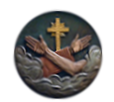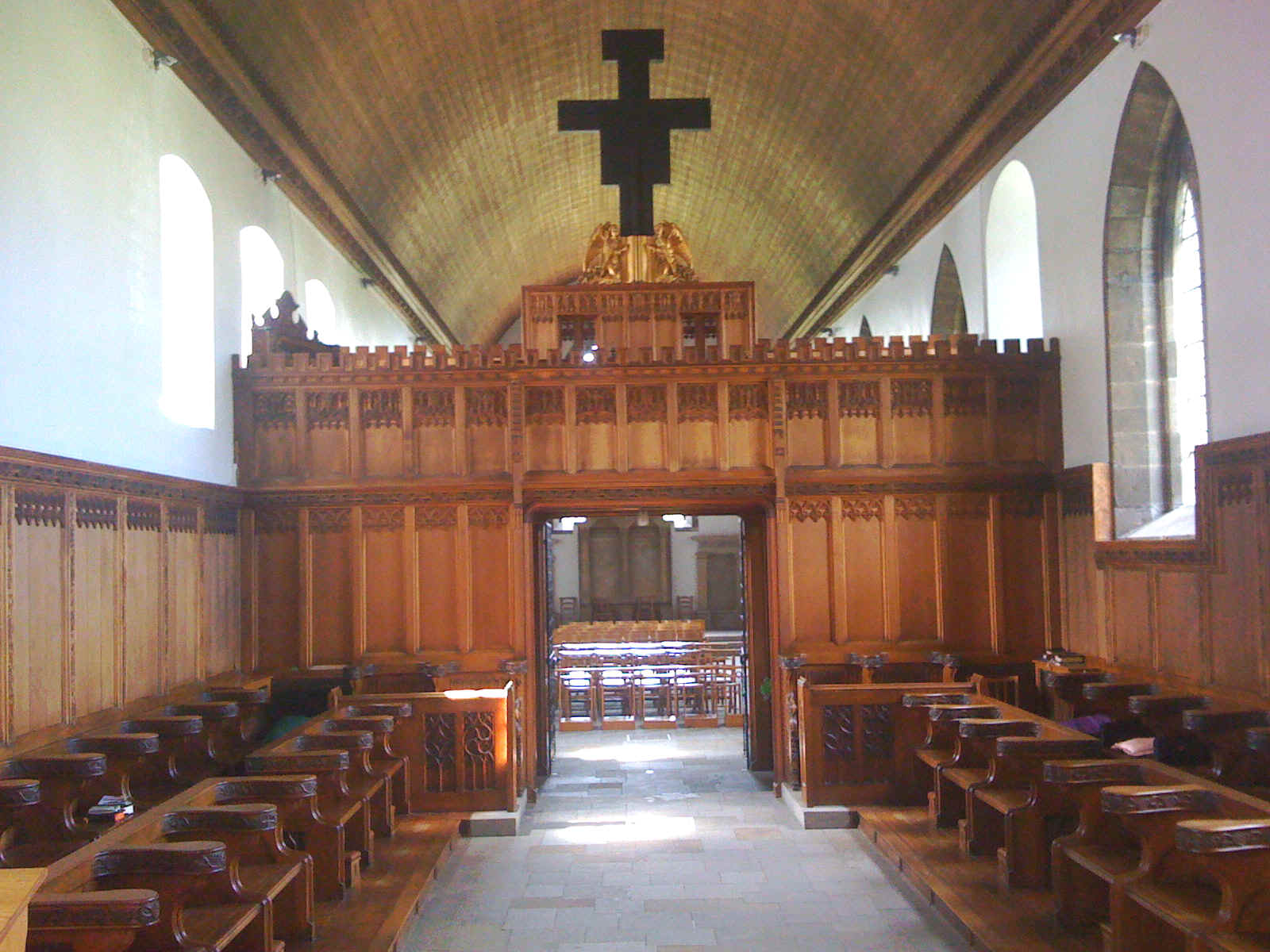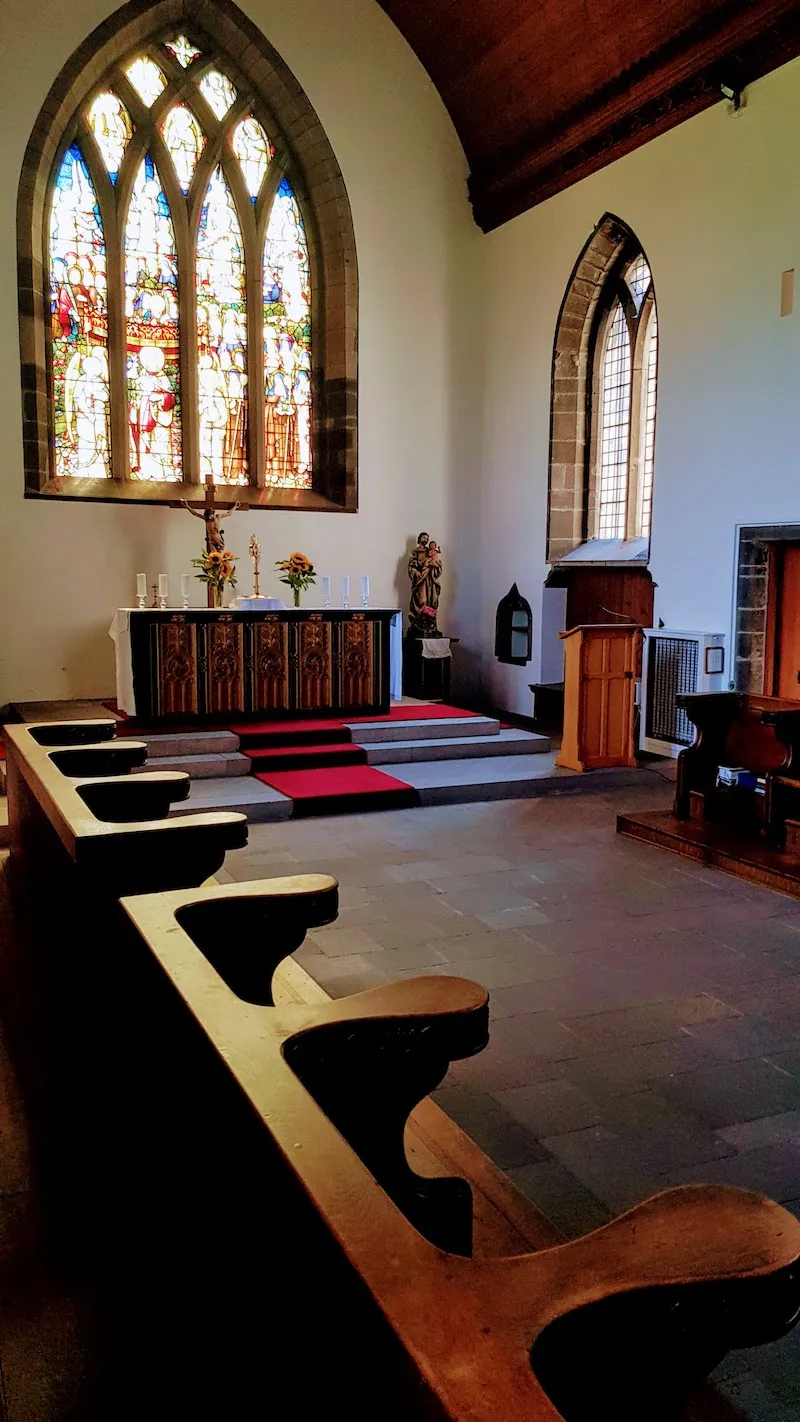- Home
- Contact Us

Elgin Greyfriars
A General History of the Scottish Grey Friars
The idea of sending a Franciscan mission, first into England, found acceptance at the Chapter General of the Order held in 1224 at Assisi - the last such Chapter attended by St Francis himself. Friar Agnellus of Pisa, the first Warden of Paris, was designated the leader of the mission, and with him were associated eight other friars, five of whom were laymen along with three English clerics of the Paris convent. This was arranged so that they would have no difficulty with the language. They were ferried across the Channel by the monks of Fécamp, and landed at Dover on 10th September 1224. From Dover they proceeded to Canterbury and thence to London, where they gradually separated to carry out their mission in various parts of the country. Within seven weeks of their arrival they had established friaries at Canterbury, London and Oxford, the ecclesiastical, political and intellectual capitals of England. In time, the sheer number of their convents became such that England was divided into groups called Custodies, the most northerly being that at Newcastle. It was from this convent that the Friars passed into Scotland, settling first at Berwick (1231) and Roxburgh (1232 - 1234). As offshoots from the English Province , the friaries at Roxburgh and Berwick were naturally placed within the Custody of Newcastle for administrative purposes in spite of their demand for autonomy. It was only in 1235 that the Province of Scotland was established as an equal to her southern 'sister', but this action was reversed in 1239. However, the Scottish Friaries, with the support of the King, continued to argue for their independence from England and it is very likely that they enjoyed a de facto autonomy. It was not until the time of King Robert the Bruce, a staunch supporter of the Order, that matters were resolved and "in 1329 the Scots friars obtained a certain Vicar of the Minister General and were wholly separated from the friars of England." The Scots were represented by their own Provincial for the first time in the General Chapter which met at Perpignan, in the Franciscan Province of Provence, in 1331.
Because of the almost endless warfare between the two countries, the progress of the Scottish mission went more slowly than it had done south of the border, but, in the course of time, eight Conventual Friaries of the Order were founded at Berwick, Roxburgh, Haddington (1242), Dumfries (1262), Dundee (1284), Lanark (1328), Inverkeithing (before 1385) and Kirkcudbright (1455). The customary residence of the Conventual Provincial Vicar (the caput provinciae) was at the Dundee convent where the Ordinary Authority was the Bishop of Brechin.
Within the Franciscan Order there were three separate families or groups, each considered a religious order in its own right. All three followed the Rule of St Francis of Assisi but each placed different emphases on the various facets of the Rule. The first group, whom we have already met, were the Friars Minor Conventual. The second group, whom we are about to meet, are the Friars Minor Observants1. There is a third group, the Order of Friars Minor Capuchin.
The Friars Minor Conventual gradually 'lapsed' in Scotland but, in 1446, at the request of the King of Scots, John de Maubert, Vicar Apostolic and General of the Order, sent "the holy father Cornelius of Zierikzee with six companions from the Province of Cologne to Scotland." This group of friars settled in Edinburgh, first at the Chapel of St John the Baptist outside the West Bow, before moving to a site at the top of Candlemaker Row sometime before 1479, where the famous Greyfriars Church still stands to this day. James Douglas of Cassillis was of great assistance to them in these early days. The efforts of these Friars resulted in the foundation by 1505 of nine Observantine convents throughout Scotland, of which Elgin was one.
Their second house was established in the university town of St Andrews c.1458 and, thanks to the good offices of Laurence, first Lord Oliphant (1434 - 1498), a third was erected at St John's Town (Perth) in 1460. Their fourth friary was established in Aberdeen, c.1469,2 mostly through the generosity of the Burgesses and their wives, but Richard Vaus of Many (Mennie) and James Bisset were instrumental too. Three years later the friars settled in Glasgow and it was from this friary, and that at Perth, that a number of the brethren who "had the Gaelic," drifted out into the wild country surrounding Dunkeld to assist the work of Bishop George Brown (1483 - 1515) among the Highlanders. The sixth friary, at Ayr, was created in 1474, thanks to the generosity of the merchants of Ayrshire, and, as we shall see, the seventh at Elgin in 1479, by Innes of Innes. The friary at Stirling was erected by King James IV, at his own expense, and he spend much time resident in the house, particularly during Holy Week. Within a month or two after Flodden, and before the end of 1513, the last, and ninth, of the Scots Observantine Friaries was erected in the burgh of Jedburgh.
In the matter of church furnishings, the seven Observatine friaries that were erected before 1493, which includes Elgin, found a lavish benefactress in Elizabeth Vindegatis, whom they admitted to the Third Order in recognition of her gift of 3000 merks Scots expended upon chalices, ornaments, candlesticks, images, bells and other necessaries.
The Grey Friars in Elgin
It is said by some, but in error, that a house of the Grey Friars Conventual was first established in Elgin in the time of King Alexander III. (1249 - 1286). What we are told for certain is that, possibly c.1284, a group of Conventuals visited the episcopal burgh of Elgin, where they received a cordial welcome from the Bishop of Moray and an invitation to settle in the diocese.3 It is thought that they did, indeed, settle for a short time at Elgin in a hospitium or rest-house near the Cathedral. However, they soon found that the Black Friars had already established themselves in the town (1230-34); and so the Conventuals declined the offer of the Bishop to establish a permanent friary. This was in accordance with their then invariable custom of refusing to accept a friary in a locality already colonised by the Dominicans. "Dundee thus remained the northern limit of their influence until the Reformation."4
A charter of William, Earl of Ross, dating c.1255, states that he, "in compensation for the damages, injuries and losses to the churches of Petty and Brackley, imposed on him by Archibald, bishop of Moray, has given, granted, and by this his charter has established, to Elgin Cathedral and Bishop Archibald and the Chapter of the same place, in pure and perpetual alms, two davochs of land in Ross called 'Kattepoll' (Cadboll)
{NGR: NH 878777}, and one quarter-land called ‘Petkenny’ (Pitkerrie) {NGR: NH 869790}, for the nourishment and support of the Friars Minor who might be dwelling at the time in their house at Elgin near the cathedral church. The bishop of Moray will appoint some prudent man and faithful administrator, who each year, at its terms, will receive all manner of the rent of the said lands in full, and will distribute them beneficially to the sustenance and necessary uses of the said brothers as should seem best. And if the said Friar Minors are unwilling to stay, the rents of the said lands will be converted for the support of two chaplains in the cathedral church of Elgin, celebrating mass for the souls of all the faithful departed, by the advice of the said bishop and Chapter of Moray. The earl wills and grants that the bishop and his successors are to hold the said lands in pure and perpetual alms."5 It is clear from the wording of this Charter that, at the time it was granted, the Friars Minor were not yet established in the city, and the important caveat included in it demonstrates this fully. Indeed, the Earl seems not to be sure that, if they were there, that they were going to stay! It must be noted that the Earl's grant was made to the Bishop and his Chapter not directly to the Friars. Even if they had intended to stay, their Rule forbade them to 'own' property. All that might have been possible was for the Bishop to receive the grant from the Earl and for him then to pay allowances to the Friars. However, as we have seen, all this came to nought and, as the evidence below seems to show, the income from the lands granted by the Earl was diverted to support what in time became known in the Cathedral as the Ross Chaplainries.
Later, in the time of Bishop John Winchester (1437 - 1458), in a list of Cathedral Clergy we find, "una capellania de Ros" and "alia capellania de Ros," entries which authorities such as Dr Cooper, in the The Church and Convent of the Greyfriars, Elgin, regards as fair evidence that the endowments of Earl William had fallen to the Cathedral, the Grey Friars not having been willing to remain.6 In a charter of Bishop William Tulloch, dated 29 November 1478,7 it seems to be made clear that Earl William's endowment was for the support of two chaplains - no mention is made of the Friars Minor! As a matter of interest, the two chaplains then in post are signatories as witnesses to this charter - Gilbertus Richardi and Johannes Willelmi.
The original site of the Observantine monastery is just to the north of the present site, at the east end of the High Street, to the south of the Little Cross. This is the site where Proctor and Patterson's Garage used to stand. Some of the present buildings in Elgin are dated to 1479. It was in that year that, "John, Laird of Innes, of highest rank among the nobility of the northern parts of the kingdom, moved to penitence and fervour by the preaching of the friars resident in Aberdeen, erected a magnificent convent in the town of Elgin, wherein there tarried twenty-four priests, most dilligent in preaching the Word of God, and in hearing the confessions of the people and the many clergy there."8 There is a Bull of Pope Sixtus IV dated at Rome, 1479, confirming the erection of this monastery. In addition, there is a charter, dated at Elgin, 28 September 1480, granting to the Greyfriars permission to cut down trees in Quarrel Wood (Oak Wood) wherewith to build and repair their monastery, and to have other wood for firewood in perpetuity, seeing they had no possessions or taxes to live upon."9 This charter was signed by Alexander Sutherland, and by his son and heir, William.
Compared with some other parts of Scotland the Reformation touched lightly on the people of Elgin and it is surprising to find the comment that, "the Greyfriars Monastery was torched by Alexander Innes, grandson of the founder laird, it having existed only 81 years." It is difficult to determine if this statement is correct but, since we find the buildings being used as a courtroom soon after the Reformation winds had blown themselves out, it is possibly untrue.
Guardians of the Elgin Convent.
Francis Innes, uterine brother of the founder, was the first Guardian of the Observantine house.
Friar Bernard Chisholm was elected Guardian in 1490. He died in the sight of all the Brethren at Elgin in 1513, aged 78 years. Friar Antony Fraser, priest, was the constant companion of Friar Chisholm. He had great preaching gifts.
Friar Robert Stuart, when a deacon of the Cathedral, joined this monastery. He was Guardian of the Elgin convent for many years, and took part in the controversy which arose at this time between the Conventuals and the Observantines as to a disctinctive form of dress. He, and the Guardian of the friary in Edinburgh (Andrew Cairns, were summoned to appear before the Bishop of Brechin along with the Provincial of the Conventuals (John Connelson) and the Warden of the Conventual house of Dundee (John Ferguson) to settle the dispute - the Conventuals demanded that the Observantines should wear the distinctive 'badge' on their habit, as had been originally provided for by a Bull of Concordance from Rome, so as to differentiate them from the Conventuals. The Observantines are said to have won the case! The first mention of this friar Robert is in a letter by Henry
VII to Sir Gilbert Talbot, deputy of Calais, written around 1507, warning
Talbot not to allow passage into England of ‘a frere Observant called frere Robert Steward, being a Scottishman’. Some scholars believe that Robert was a member of the Royal Family which, if true, would have cause the English authorities to be suspicious of him. He is thought to have died at the St Andrews friary some time in 1555, at the grand age of eighty.
The last Guardian was Friar Antony Urquhard of the ancient family of Urquhard. He tried to quell the sacrilege of devastation in 1560, when "The Earl of Huntly, then Master of Moray, invaded the town of Elgin, laid waste the Cathedral Church and all the Religious Houses in the city, hounding on the mob."10
The family of Innes is inextricably linked with the history of the convent. After the Reformation, the Crown did not assume responsibility for the friary and nunnery lands until 1571.11 Then, the whole of its 'possessions' were given to Robert Innes of Innermarkie, under a feu-duty of forty shillings, dated 20 April 1573.12 The church was long used as a place of meeting for the Criminal Courts when the Lords of Justiciary visited Elgin.13
For some years after 1676 the property belonged to the Bishop of Ross (John Paterson 1662-1679), who "out of his Lordship's mere kyndness, favour and guid-will" granted permission to the Crafts (Incorporated Trades) of Elgin to hold their meetings within the Church.14
After the Restoration in 1689, the Church was occasionally used as a place of worship by a non-juring Episcopal minister; but it gradually fell into disrepair and by 1891 only parts of the walls remained. The property was then occupied by the Sisters of Mercy; and shortly afterwards, the third Marquis of Bute, John Crichton-Stuart, most generously restored both Church and house to as near their original condition as possible for the permanent use of the Sisters. Fortunately, the west wing of the conventual buildings had remained almost intact whilst the east wing and the glazed cloisters were rebuilt on their former foundations. Happily too, the old well of the convent was also preserved in its central position in the cloister-garth.

Above: The east gable of Greyfriars church with some of the conventual buildings.
Once the ambitious programme of re-building had been completed, on 4th October 1898, the reopening ceremony took place. The convent had been re-built largely due to the generosity of Lord Bute. Present at the service were the Marquis and his wife, the Lady Margaret Stuart, the Duke of Norfolk, and a representative gathering of clergy and public men.
We have recently published a paper written by one of the ministers of Aberdeen for the Transactions of the Aberdeen Ecclesiological Society in 1891. In it, the Rev. J. Cooper, M.A., minister of one of the charges at St Nicholas parish church, records a considerable amount of detail and, most interestingly, includes three fine architectural scale-drawings of the ruins, made before the above-mentioned restoration.

Above: The 'Rood Screen' of Greyfriars church, as it is today.

Above: The 'Sanctuary' of Greyfriars Convent, as it is today.
The Sisters of Mercy inhabited Greyfriars until 2010 and then, in 2013, a group of Dominican Sisters of St Cecilia arrived, having been invited by the Bishop of Aberdeen to bring religious life back into this most historic convent.
References
1. The Observant friars arrived in England from Cologne in 1482, invited by King Edward IV., who built them a friary at Greenwich next to his royal palace. Return to Text
2. The first Friar reached Aberdeen in 1461; the friary was in course of construction in 1469; the Charter of Erection was granted the same year; sasine followed in 1471. Return to Text
3. Bryce, W. M. (1909) The Scottish Grey Friars, Vol. 1., Edinburgh: W. Green and Sons., p.361. Return to Text
4. Bryce, W.M. (1909)The Scottish Grey Friars, Vol.1., Edinburgh: W. Green and Sons., p.16. Moreover, a Bull of 1346 states that the Franciscans were then settled in "three dioceses and no more" - Glasgow, St. Andrews and Brechin. Nor is there any mention of a Conventual friary at Elgin in the Exchequer Records, the Provinciale, or the Annales Minorum. Return to Text
5. Permalink: www.poms.ac.uk/record/source/3265/ ; R.E.M., no. 220, p. 281. Return to Text
6. Cooper, J. "The Church and Convent of the Greyfriars, Elgin", Aberdeen: Trans. Aberdeen Ecclesiological Society (1891), p.45-53. Return to Text
7. Reg. Epis. Morav., no.197, p.232. Return to Text
8. Bryce, W. M. (1909) The Scottish Grey Friars, Vol. 2. Edinburgh: W. Green and Sons., pp.187. https://archive.org/details/scottishgreyfria02brycuoft/page/186 Return to Text
9. The Grey Friars were forbidden by their Rule to own property. Return to Text
10. Brockies MSS. Return to Text
11. Acts of Parliament, III. 59. Return to Text
12. Reg. Mag. Sig., XXXIV., No.32. Return to Text
13. Macintosh, H.B. (1924) Pilgrimages in Moray: A Guide to the County, Elgin: W.R. Walker & Co., "Courant and Courrier" Office, p. 31. Return to Text
14. Mackintosh (1924), p. 31. Return to Text

Return to top of page
e-mail: admin@cushnieent.com
© 2023 Cushnie Enterprises




